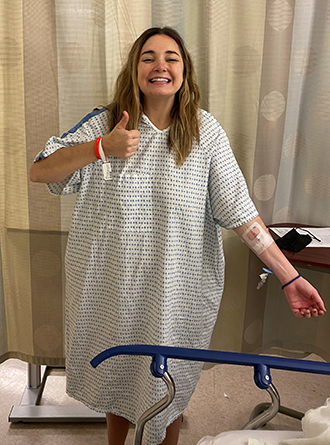
Imagine being a young, healthy, active woman, a Manhattanite who runs half marathons, travels the world, and spends holidays indulging a passion for boating and kayaking. The occasional twinge of back pain is merely a nuisance. Until, one day, you can barely walk.
That was the extreme wake-up call that 30-year-old Katie Bennett experienced in 2021. “When I went to a Giants game,” she recalls, “I realized I could barely walk through the stadium without being in serious pain.”
Katie, who is vice president of marketing for a prominent financial services company and an adjunct professor of professional writing at a major New York university, first sought help from her primary care physician, who referred her to a specialist in physical medicine. An MRI followed, along with a diagnosis of pressure on her sciatic nerve from a herniated disc in her lower back (L5/S1, to be specific).
Since she had not suffered any injury that would explain it, and had not experienced anything like it before, Katie could only hazard a guess as to what had happened: “Working from home for nearly two years may have affected my spine in a negative way, to the point where the disc was not where it was supposed to be.”
An epidural from a pain management specialist offered little to no relief, she remembers. Eventually she was referred to a neurosurgeon who specializes in spine conditions, Dr. Lynn McGrath at Och Spine at NewYork-Presbyterian at the Weill Cornell Medicine Center for Comprehensive Spine Care. Dr. McGrath is a pioneer in the newly emerging field of endoscopic spine surgery, and he knew that this minimally invasive approach would be especially suitable for a young, active patient like Katie.
“Spine surgery has really changed over the past twenty years or so,” says Dr. McGrath. “The interventions have become smaller and smaller, especially with image-guided surgical navigation systems that allow us to operate without the large incisions that were typical of older techniques. Endoscopic spine surgery is the latest frontier – using these tiny cameras and tools we can repair certain spine problems through an incision less than an inch long, making recovery remarkably fast.”
“Dr. McGrath explained endoscopic surgery over the phone and asked if I had any reservations,” Katie says. “I had none, so he went ahead and scheduled the surgery, which was all I wanted — a solution. I was tired of taking serious pain medications, and the steroids were taking a real toll on me.”

“Not every patient is a good candidate for the endoscopic approach,” says Dr. McGrath, “but I knew Katie was, and it is very gratifying to be able to offer this option when it’s appropriate. Katie’s surgery took just about an hour, and she was awake in recovery in no time at all.”
Katie could not have been happier when she woke up. “Walking into the hospital that morning I had barely made it from the curb into the room without needing a wheelchair,” she recalls. She was out of bed shortly after waking up in recovery and reports that she was “on my couch that night and walking in Central Park the next day.”
Best of all, the debilitating pain was gone. “I tell everyone I feel like I got six inches of my height back because I had been hunched over for so long!” she laughs.
Katie’s recovery was uncomplicated – her prescribed regimen was to walk one hour a day for six weeks, then return to her regular physical activities.
“After six weeks, I was able to return to Spin class and start running again, and I didn't even need physical therapy,” she reports. “I just took my time getting back into working out, making sure my body was ready. But other than rebuilding stamina, I was right back to how I felt before the pain had started.”
Dr. McGrath is especially pleased with having the endoscopic option to offer patients like Katie. “At most the incision requires only one or two stitches to close, and sometimes not even that,” he says. “There are some instances when a small adhesive strip is all we need. For getting a problem solved with minimal intrusion and fastest return to normal life, there really is nothing like endoscopic surgery.”

Katie has some advice for others who are struggling with back issues that might be helped with endoscopic surgery: “There is absolutely nothing scary about this,” she says. “It’s practically noninvasive, and I felt as if I literally had the knife pulled out of my back. The surgery really did give me my life back, and quickly.”
More about endoscopic spine surgery
More about Och Spine at NewYork-Presbyterian at the Weill Cornell Medicine Center for Comprehensive Spine Care